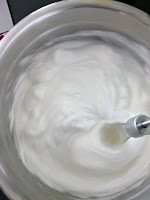I love cheesecake and have been hearing about this trendy light Japanese crustless version, so I tried to make it. On my third attempt, I think I've come up with something that works well: it's fluffy, almost soufflé-like. Everything here is taken from the exquisitely-detailed recipe/technique from Nami at Just One Cookbook, so look there for better photos and descriptions, including a link to a helpful video. Hers looks a lot more professional than mine, but I'm happy with the flavor and texture I've gotten with my too-short pan.
 |
| Cheesecake has a muffin top due to my short cake pan |
For my first try, I used her parchment lining technique but with a springform pan and was annoyed by the fidgety parchment lining; worse, the water bath seeped through my tin foil lining making the bottom a bit soggy. For my second try, I realized I didn't need to line the springform pan -- it would release fine -- and I put the water bath below the cake pan (for humidity) instead of bathing the pan: it came out dense on the bottom, indicating the cake needed the heat moderated by the bath. On my third try, I used a solid pan -- as Nami does -- directly in a water bath, and just dealt with the parchment lining; my pan is slope-sided where hers is straight, which makes lining a little more difficult, but it doesn't have to be exact; it worked well enough that I don't think I need to buy another pan with straight sides -- I can live with the muffin-top profile.
Her recipe is long, but very detailed, which I appreciate. First, note that if your pan is smaller than hers/mine, she provides ingredients scaled to a single egg, then she provides the full 6-egg recipe, so you can scale for your pan.
As an overview, you "melt" the cream cheese and other batter ingredients then whisk in the egg yolks and flour to make a batter. Then you whip the egg whites into a stiff meringue, then gently fold them together. I follow her advice about dropping the oven temperature twice.
The 6 eggs barely fit my slope-sided pan which is 20 cm at bottom and 23 cm at the top; the parchment lining must be higher than my pan's 4 cm to accommodate the rise, but the parchment lining flexed and created the muffin-top shape. If you have a different sized pan, scale the recipe appropriately, but realize this will rise dramatically before falling while it slowly cools.
Do take her advice to measure the ingredients beforehand: there's plenty of prep work. I'm trying to simplify this a little by combining measuring into cooking vessels.
Prep the Cake Pan
Use a 23 cm / 9 inch solid cake pan, preferably 10 cm / 4 inch high (mine's only about 4 cm).
Butter the pan bottom and sides so the parchment will stick.
Cut parchment strips to make straps long enough to cross the bottom, up the sides, and over the edge; set them in an X-shaped pattern to make a sling to remove the finished cake.
Cut another strip 10 cm high and line the side of the pan.
Cut a disk for the bottom and press into place.
Set aside.
 |
| Sling straps, sides and bottom lined |
Batter
6 Eggs, large
300 g Cream Cheese
60 g Unsalted Butter
200 ml Heavy Whipping Cream (about 35% fat)
Zest from 1/2 Lemon
30 ml Lemon Juice (from about 1/2 lemon)
80 g Cake Flour
Separate the Eggs and chill the Whites for the Meringue below.
Make a double boiler from a pot of water topped by a medium-sized bowl.
Weigh the Cream Cheese, Butter, Cream, Sugar directly in the bowl.
Add to the double boiler and warm to melt the ingredients, combining with spatula or whisk.
When blended, remove from heat.
Sift in the Cake Flour through a strainer, and whisk to blend.
Strain through the strainer into a large bowl.
Whisk in the Lemon Zest and Juice.
Whisk in the Egg Yolks, one by one, with a hand whisk.
Prepare Oven and Water Bath
Put a roasting pan in the oven and preheat to 165C with convection (15C higher without).
Bring 1 Liter of water to boil.
Meringue
6 Egg Whites from above, cold
100 g Sugar
1.5 g Cream of Tartar (optional to stabilize)
Clean the medium bowl thoroughly for the Meringue: don't leave any fat, soap, or water on it which would interfere with the development of the foam.
Whip the Egg Whites with an electric whisk (stick blender attachment) on medium until opaque, foamy, and just a little bubbly, about 2-4 minutes.
Whisk in the Sugar and Cream of Tartar, a bit at a time, then increase whisk speed to high; whip until quite dense and it forms stiff peaks.
Gently fold in a third of the Batter with a hand whisk, then repeat with another third, then finally mix it back into the Batter and gently combine with the whisk.
Pour into the lined cake pan.
Pour boiling water carefully into the hot roasting pan, then place the cake pan in water bath; ideally the water will come half way up the cake pan.
Drop the temperature to 145C convection, bake 70-75 minutes.
Reduce temperature to 135C convection and bake another 10 minutes.
Check for doneness: a skewer should come out clean.
Turn off the oven and open the door a crack but let the cake cool very slowly to minimize collapse.
After 20 minutes, remove from the oven.
Use the straps as a sling and move the cake to a plate.
Remove the parchment around the sides.
Let cool and serve.





























